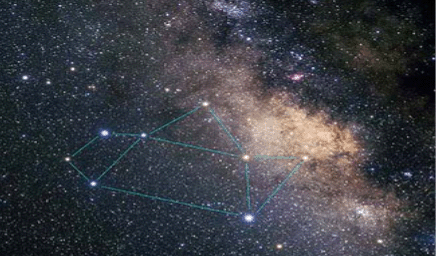Summer Constellations
The Summer Triangle

The Summer Triangle is made up of three bright stars—Altair, in the constellation Aquila, the eagle, Deneb in the constellation Cygnus, the swan, and Vega in the constellation Lyra, the lyre (or harp).
Also called “The Northern Cross” or “The Backbone of the Milky Way,” Cygnus is a horizontal cross of five bright stars. In very dark skies, Cygnus helps viewers find the Milky Way. The last star in Cygnus’s tail, Albireo, is actually two stars, also called a binary star. With 30 power magnification, it is easy to see the dim blue star and bright orange star that make up Albireo. The Ring Nebula, found in the constellation Lyra, can also be seen with this magnification.
In Japanese mythology, Vega, the celestial princess and goddess, fell in love with a man named Altair. Her father did not approve of Altair, since he was a mortal, and forbade them from seeing each other. The two lovers were separated by the Celestial River, represented by the Milky Way. According to the legend, once a year, a bridge of magpies form, represented by Cygnus, and the lovers can, momentarily, be together again.
Scorpius

Sometimes called Scorpio, Scorpius is one of the Zodiac constellations. There are 12 zodiac constellations that each appear at a different time in the year, based on the Earth’s position around the sun. Those born under a specific sign theoretically share personality traits and moods, discussed in horoscopes. This is not a scientific discipline. Scorpius represents those born during October 23 to November 21.
Scorpius is easy to spot in the summer sky. It is made up of a long string of bright stars, which are visible in most lights. Antares is especially easy to see because of its distinctly red color. It is about 850 times bigger than our sun and is a red giant, meaning that it is in the last stage of its star life. In Scorpius’s trail are two star clusters– M7, also called Ptolemy’s Cluster and M6, also called the Butterfly Cluster.
In Greek mythology, Scorpius, the scorpion, was the downfall of the great hunter, Orion. This is why Scorpius seemingly chases the constellation Orion across the sky, which only appears in the winter.
The Teapot

Nine bright stars in the constellation Sagittarius make the shape of a teapot. It can usually be found low in the summer sky. The spout of the teapot points directly to the center of the Milky Way. The formation is also close to the star clusters M22 and M28 in the night sky.
The Teapot is a smaller portion of the larger constellation Sagittarius. Like Scorpius, Sagittarius is a Zodiac constellation and represents those born from November 22 to December 21. According to Greek mythology, Sagittarius, the centaur, invented archery, and was placed in the stars to reward his skill. Sagitarius also may represent Chrion, the centaur who trained the hero Hercules. Chiron was immortal, but was accidentally shot with a poison arrow by Hercules and could not die. He volunteered to go to Tartarus in the titan Prometheus’s place, and was put in the stars to reward his sacrifice.
To read more about these constellations and get the latest update on astronomical news, visit EarthSky.
Download a PDF Version of this information
